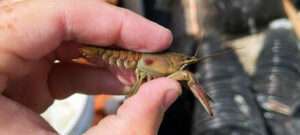 PRATT – Widespread sampling for invasive crayfish had never occurred in Kansas lakes – that is, until the Kansas Department of Wildlife and Parks (KDWP) recently funded a university project focused on the freshwater crustacean. KDWP’s Aquatic Nuisance Species Program and Ecological Services section funded the project with the overarching goal of establishing sampling protocols that could then be used for long-term monitoring of both native and invasive crayfish in Kansas. To the surprise of staff and researchers, the need for such protocols would be validated almost as quickly as the research project began.
PRATT – Widespread sampling for invasive crayfish had never occurred in Kansas lakes – that is, until the Kansas Department of Wildlife and Parks (KDWP) recently funded a university project focused on the freshwater crustacean. KDWP’s Aquatic Nuisance Species Program and Ecological Services section funded the project with the overarching goal of establishing sampling protocols that could then be used for long-term monitoring of both native and invasive crayfish in Kansas. To the surprise of staff and researchers, the need for such protocols would be validated almost as quickly as the research project began.
During capturing efforts at McPherson State Fishing Lake – one of several small waterbodies slated to be inspected in the state – university researchers collected multiple Rusty Crayfish. Rusty Crayfish have not previously been documented in the wild in Kansas, making this official “discovery” the first of its kind. Rusty Crayfish captured at McPherson consisted of both males and females of varying ages, indicating a reproducing population is established in the lake. Unfortunately, this isn’t the type of species staff and researchers would hope to find, as the Rusty Crayfish is an invasive species known for the considerable ecological damage it can cause in waterbodies.
This large, aggressive crayfish is not only known to attack the feet of unsuspecting humans and animals standing in freshwater, it outcompetes both native fish and crayfish species for forage – forage that also acts as important cover for select prey species.
“The most likely cause of the Rusty Crayfish making its way into Kansas is through its use as fishing bait,” said KDWP Aquatic Nuisance Species coordinator, Chris Steffen. “This species is a prime example of the importance of always draining water from your boat, livewell, and bilge before leaving a waterbody, and of never moving bait from one waterbody to another. You just never know what could be hitchhiking a ride.”
Staff and researchers working on the crayfish project will continue to experiment with multiple capture methods and techniques on a small number of waterbodies around the state. Once an effective and efficient sampling protocol has been identified, staff will continue the sampling efforts across a large number of lakes across the state.
Anglers, boaters and watersport enthusiasts are encouraged to keep their eyes open for this invasive species, which can be identified by its trademark large, black-tipped claws and rust-colored spots on its upper shell. If one is discovered, freeze it in a sealed plastic bag, note the date and location of capture, and contact KDWP’s Emporia Research and Survey Office at (620) 342-0658.
For information on other aquatic nuisance species in Kansas, visit ksoutdoors.com/Fishing/Aquatic-Nuisance-Species.
ksoutdoors.com/




